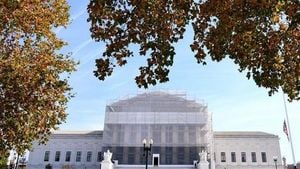On October 15, 2025, the marble steps of the U.S. Supreme Court became a stage for a pivotal struggle over the very heart of American democracy. Inside, justices heard oral arguments in Louisiana v. Callais—a case that has sent ripples of anxiety and hope through communities of color, civil rights leaders, and lawmakers nationwide. At stake is Section 2 of the Voting Rights Act of 1965, a provision that for six decades has barred discrimination in voting systems and transformed the political landscape for racial minorities in the United States.
For many, the Voting Rights Act stands as a crowning achievement of the Civil Rights movement. Its passage not only banned discriminatory practices like poll taxes and literacy tests but also laid the groundwork for federal oversight of state and local voting policies. According to the Associated Press, the Act’s reach has been profound: state legislatures in the Deep South, once bastions of white supremacy, now include sizable minorities of Black, Asian, and Latino lawmakers. Mayors, police commissioners, judges, and county commissioners—all elected as a direct result of VRA-enabled districts—now lead some of America’s largest cities and municipalities.
Yet, as the Supreme Court justices scrutinized the constitutionality of Section 2, concern mounted outside the courthouse. Black residents and supporters rallied, holding signs and chanting, determined not to let decades of hard-won progress slip away. Among those present was Rep. Cleo Fields, the Louisiana congressman whose district is at the heart of the case. Fields, who sat through the oral arguments, expressed a mix of caution and hope. “If they do away with Section 2, they know the ripple effect that’s going to have all over this nation. It’s not just Congress,” he told the Associated Press. “But I am cautiously optimistic. I really think all of the justices know what’s at stake.”
That sense of high stakes was echoed by Janai Nelson, president of the NAACP Legal Defense Fund, who argued in defense of the Voting Rights Act before the court that week. Speaking on Slate’s Amicus podcast, Nelson warned, “The consequences of losing Section 2 would be catastrophic.” She noted that many Americans are unaware of just how much their democracy is undergirded by the rights accorded in the 14th and 15th Amendments, and effectuated by the Voting Rights Act. Nelson’s words carried a sense of urgency, as she outlined the case’s implications for voting rights not only in Louisiana but across the entire nation.
The historical context loomed large over the proceedings. Section 2 has long been the mechanism by which courts remedy proven cases of racial discrimination in voting—sometimes requiring that districts be drawn with race in mind to ensure fair representation. Over the years, this provision has enabled minority communities to turn grassroots movements into direct political power. The Congressional Black Caucus, for instance, has become a hub for Black political organizing and influence, while lawmakers from VRA districts have overseen political machines that drive national politics.
But as the Associated Press reported, anxiety is growing that these gains could be reversed. Rep. Yvette Clarke, chair of the Congressional Black Caucus, voiced concern about ongoing gerrymandering efforts in states like Texas, calling them “blatant targeting” of Black lawmakers. Clarke warned that the Supreme Court’s decision “could have an impact for generations to come.”
For others, the threat is even more existential. Rep. Troy Carter, a Democrat from Louisiana, didn’t mince words: “A representative form of government means it should look like its people. If you take away the elements that create the opportunity for it to look like its people, it won’t be a democracy as we hoped it would be. It will be a much weaker one, and ultimately on the road to an oligarchy.”
The oral arguments themselves revealed a stark divide among the justices. The court’s conservative majority pressed hard on the question of how long race-conscious remedies should persist. Justice Brett Kavanaugh asked lawyers defending Section 2, “It’s the particular application of the statute that entails the intentional, deliberate use of race to sort people into different districts. I’m asking what you think the time limit on that should be, or maybe you really shouldn’t think there should be a time limit?”
On the other side, the court’s liberal justices argued that Section 2 is not a permanent mandate for race-based districting, but a tool that activates only when discrimination is proven. Justice Ketanji Brown Jackson put it plainly: “Section 2 itself is just the measure by which we determine that a remedy is required, so that’s why it doesn’t need a time limit, because it is just pointing us to the direction of where we might need to do something.”
The uncertainty has reignited memories of earlier battles. Rep. Terri Sewell, who represents a majority-Black Alabama district known for the 1965 ‘Bloody Sunday’ voting rights march, attended the arguments and left with a sense that “old battles have become new again.” Sewell, reflecting on the legacy of Selma and the ongoing struggle, declared, “Progress is elusive. The pendulum swings, and it doesn’t swing on its own. This is a continuous struggle, and we pass the baton on to the next generations. And while the baton is in our hand, I think we have to do everything in our power to maintain the representative democracy that we have and to make sure that this democracy is healthy and strong for the next generation.”
Outside the courthouse, the rallying crowd included Khadidah Stone, a plaintiff in a 2023 case that resulted in the creation of majority-minority districts in Louisiana and Alabama. Stone drew a direct line between the current lawsuit and ongoing political efforts to redraw congressional maps before the 2026 midterm elections. “We’re back because it’s very evident what the current administration is trying to do when it comes to dismantling what we currently know as democracy,” she told the Associated Press. “That entails destroying things like the Voting Rights Act because it doesn’t align with their ideals of what America should be.”
As the nation awaits the Supreme Court’s decision, the debate over Section 2 has become more than a legal argument—it’s a referendum on the unfinished, but essential, struggle for racial justice in America. The outcome will determine not only the future of minority representation in Congress and statehouses but the very character of American democracy itself. For those who gathered in Washington and millions more watching from afar, the stakes could hardly be higher.
With so much history and hope hanging in the balance, the fight to protect voting rights is far from over. As Rep. Sewell and others have reminded the nation, the struggle for a truly representative democracy is not a relic of the past, but a living, urgent challenge for every generation.




